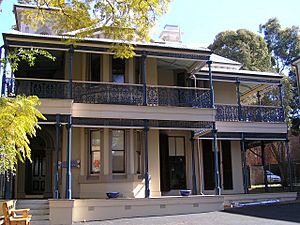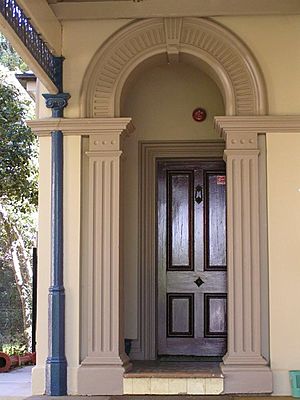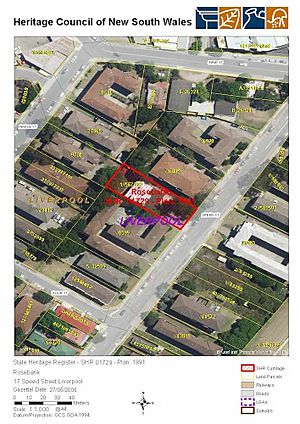Rosebank, Liverpool facts for kids
Quick facts for kids Rosebank |
|
|---|---|
 |
|
| Location | 17 Speed Street, Liverpool, Sydney, New South Wales, Australia |
| Built | 1882–1883 |
| Architect | Varney Parkes |
| Owner | Liverpool City Council |
| Official name: Rosebank; Queens College | |
| Type | state heritage (built) |
| Designated | 27 May 2005 |
| Reference no. | 1729 |
| Type | House |
| Category | Residential buildings (private) |
| Lua error in Module:Location_map at line 420: attempt to index field 'wikibase' (a nil value). | |
Rosebank is a special old building in Liverpool, Sydney, Australia. It was built between 1882 and 1883. This building has been many things: a family home, a boarding school called Queens College, and now offices.
A famous architect named Varney Parkes designed Rosebank. Today, the Liverpool City Council owns it. Because of its history and unique style, Rosebank is listed on the New South Wales State Heritage Register. This means it's an important part of the state's history and needs to be protected.
Contents
Rosebank's Story
Building a Home
Rosebank was built in 1882–1883 by Varney Parkes. He was an architect, which means he designed buildings. Varney Parkes was also a politician, someone who helps run the government. He built Rosebank for his new wife, Mary Cameron Murray. Mary's family owned the land where the house was built. Varney Parkes was also the son of a very important politician, Sir Henry Parkes.
New Owners and Changes
In 1883, Rosebank was sold to Louis Haigh. He was involved in the wool business and was also the mayor of Liverpool. A mayor is the leader of a town or city. Over the years, many important people lived in or rented Rosebank. For example, Henrietta and Martin Christiansen owned a brick-making business. Martin was a local council member (called an alderman) for 30 years and was mayor in 1900.
Around the early 1900s, the back porch of the house was probably closed in.
From School to Offices
In 1929, a man named Rev. William Bain bought Rosebank. He turned it into Queens College, a boarding school. First, it was for girls, and later, it became a school for boys. During this time, a new two-storey building was added to the back. The school closed in 1957, and the building went back to its original name, Rosebank. From 1958 to 1973, it was used as a place where men could rent rooms.
In 1974, the Liverpool City Council bought Rosebank. They started using it for community offices and meeting rooms. The newer part at the back was updated, and some old stairs were removed. An old weatherboard building next to Rosebank was also taken down.
What Rosebank Looks Like
Rosebank is a two-storey house built in a style called Victorian Italianate. This means it has features like those found in old Italian buildings. It has a tower and is not perfectly symmetrical. The house is made of brickwork covered in a smooth finish. It has decorative bands (string courses) and windows with rounded tops. These windows have special keystones and fancy columns (fluted pilasters). The roof edges (eaves) have decorative brackets. Some walls also have a castle-like top, which is called crenellated.
Gardens and Trees
Rosebank has gardens both in the front and back. The front garden has large, old trees. You can see a beautiful jacaranda tree (Jacaranda mimosifolia) hanging over the front fence. There are also tall gum trees (Eucalyptus sp.), a Bunya Bunya pine (Araucaria bidwillii), and a Canary Island date palm (Phoenix canariensis). These trees are all on the front lawn.
The Verandah and Entrance
A wide porch, called a verandah, runs across the front of the house and down both sides. It has decorative cast iron columns, railings (balustrade), and fancy panels (frieze). The verandah roof is rounded (bullnosed). The main roof of the house is steeply sloped (hipped). It was originally made of slate but now has corrugated steel. The main entrance to the verandah has a small, fancy archway (pedimented porch). It even has the initials "LH" for Louis Haigh, an early owner.
The entrance porch has colorful patterned tiles and a beautiful stained glass window. Most of the windows are tall timber windows that slide up and down.
Inside Rosebank
Inside, the ceilings are made of plaster and have fancy decorative edges (cornices) and round designs (ceiling roses). The walls are plastered brick. The house has tall wooden baseboards (skirting) and marble fireplaces with cast iron decorations. The doors have four panels. The stairs have decorative wooden railings.
A two-storey brick addition is at the back of the building. It was built in the mid-20th century and updated in 1974. Some parts of this addition need repairs.
Overall, Rosebank is still in good condition, and many of its original details are still there.
Why Rosebank is Special
Rosebank is considered very important for its history and design. It's special for many reasons:
- Designed by a Famous Architect: Rosebank is important because it was designed by Varney Parkes. He was a very successful architect and politician. He designed many different types of buildings across New South Wales. Rosebank is one of the few homes he designed that still exists. He designed it for himself and his wife, showing off the architectural styles of the time.
- A Unique Old House: Rosebank is a grand, old Victorian house that still looks much like it did when it was built. It's the only large Victorian house left in the historic Liverpool area. Local people think it's very important.
- Connected to Important Families: Many important families from the late 1800s and early 1900s lived in Rosebank. These families helped develop Liverpool's industries and politics.
- Changing Uses: The way Rosebank has been used over time – from a family home to a school and then offices – shows how Liverpool has changed. It's a rare example of a large house that became a school. Queens College was an important part of Liverpool's community for many years.
- Special Gardens: The garden still has some of its original Victorian plants, like the old Bunya Pines. The building's unique shape and its old trees make it a local landmark, easy to spot in Liverpool.
- Rare Example: Rosebank is one of the only buildings of its kind from the Victorian era left in Liverpool. It shows a way of life from the past that no longer exists. Other similar large homes have been torn down. Its use as a boarding school was also unusual for a single house in the area.
Rosebank helps us understand the history of Liverpool, from its early settlement to its industrial growth. It's a great example of a grand house from the 1800s.



